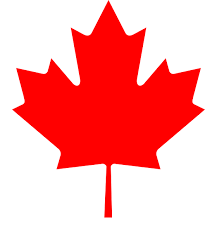Read the text "The symbols of Canada".

The search for a new Canadian flag started in 1925 (they used the British flag, the Union Jack). But the work wasn’t completed. Later, in 1946, a parliamentary committee was appointed and received more than 2,600 designs. Still, the Parliament of Canada was never called upon to vote on a design.
Only in 1964, after eliminating various proposals, the House of Commons and the Senate approved the national flag of Canada. The design consists of a red flag with a single red maple leaf on a white square.
The official ceremony inaugurating the new Canadian flag was held on Parliament Hill in Ottawa on February 15, 1965, with the General Governor, the Prime Minister, the members of the Cabinet and thousands of Canadians.
The approved design was based on Canadian history. The combination of red, white and red first appeared in the General Service Medal issued by Queen Victoria. Red and white were proclaimed Canada’s national colours by King George V in 1921. All Canadian Olympic athletes have worn the single red maple leaf on a white field as Canada’s emblem since 1904.
The Union Jack may be displayed with the Canadian flag at the National War Memorial and in connection with ceremonies in which Canadian forces participated with other Commonwealth forces.
The present design of the coat of arms in Canada was approved in 1994. The design reflects the royal symbols of Great Britain and France: the three royal lions of England, the royal lion of Scotland, the royal fleurs-de-lis of France and the royal Irish harp of Tara. On the bottom of the shield is a sprig of three Canadian maple leaves representative of Canadians of all origins. Canada’s motto “A Mari usque ad Mare” (from sea to sea) is written on the coat of arms.
The national anthem of Canada is called “O Canada”. It was proclaimed Canada’s national anthem on July 1, 1980, a century after it was first sung on June 24, 1880. The music was composed by Calixa Lavallje, a well-known composer. French lyrics to accompany the music were written by Sir Adolphe-Basile Routhier.
Many English versions have appeared over the years. Mr. Justice Robert Stanley Weir wrote the version on which the official English lyrics are based in 1908. The official English version includes changes recommended in 1968 by a Special Joint Committee of the Senate and the House of Commons. The French lyrics remain unaltered.
Choose true, false, doesn’t say:
1. The present design of the coat of arms in Canada was approved in 1984.
2. The national anthem of Canada is called “O Canada”.
3. The writer likes to sing the national anthem because he lives in Canada.
Ви повинні авторизуватися, щоб відповісти на завдання. Будь ласка, увійдіть в свій профіль на сайті або зареєструйтеся.